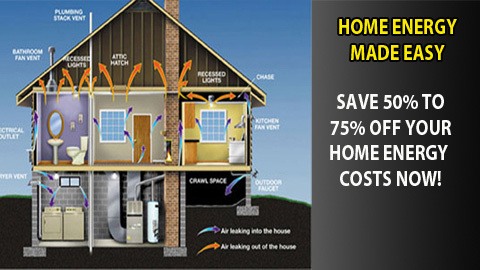Click Video to Watch
Course Summary: Saving Energy Tips
The most important thing you need to take away from this lesson is…
Saving Energy in the Basement

This chapter covers the things you need to know to properly update and air seal your basement for saving energy. Up to 25% of heat is lost through your basement.
We'll discuss the different kinds of basements and ways of dealing with heat loss with each. We're going to discover where your basement is vulnerable to heat loss and systematically put a stop to wasting your money

Most homeowners don’t think of their basement as a prime source of heat loss, yet basements can account for 20% to 35% percent of a home’s total heat loss.
Basements lose so much heat because of the large, uninsulated surface area both above and below grade level. Contrary to popular opinion, earth is a poor insulator.
There is also a lot of air leakage through basement windows and penetrations, through cracks, and at the top of the foundation wall (sill area).
Some basements have no insulation at all, and for most homeowners this means there is much potential for improvement. Insulation can often be tied in with other repair or renovation work, such as damp-proofing or finishing the basement.
Before planning the job, assess your basement. The following are some of the problems to look for.
Water Leakage
Major water leaks (persistent leaks and flooding in the spring and when it rains) must be corrected. This could be as simple as sloping the grade and directing downspouts away from the foundation. Often the solution requires excavating, damp-proofing, adding a drainage system and insulating from the exterior.
Minor water leaks can sometimes be corrected by directing water away from the foundation and patching the foundation on the interior.
Correct problems with sump pumps or sewer backup before insulating.

Dampness
Symptoms of dampness include staining or mold growth, blistering and peeling paint, efflorescence (a whitish deposit on the surface), spalling (deterioration of the surface) as well as a musty smell. Minor dampness may be corrected from the interior; more serious problems should be corrected from the outside.
Condensation can also form on the foundation walls in the summer because the air is very humid and the basement is cool.
Cracks
If the basement has an “active” crack (i.e., one that gets bigger or smaller), you should seek professional help to determine if the situation requires structural repairs.
Types of Basement Construction
The most common type of basement is the full foundation basement. It may or may not be finished or be considered a living space. Full foundations can be made of many different materials, as described below.

Many houses have been built with a partial depth foundation that creates a crawl space under the house.
Some older homes and cottages are built up on posts and piers. The space below the house is open to the outside, although this can be blocked off. Other houses are built on a slab-on-grade where there is no basement or crawl space at all.
Whatever the type of construction, most basements/foundations have no insulation at all. Even if your house has been built since the mid-1980s, it may at best have partial-depth insulation.
Concrete Foundations
Poured or concrete-block foundations have been built since the 1920s, usually with parging, damp-proofing and drain tiles on the exterior. However, anything more than 20 years old is likely to be in need of repair. This type of basement can be insulated from the outside or inside as long as there are no serious water or structural problems.
Older Foundations (Rubble, Brick, Stone)
Older foundations made of rubble, brick or stone are often uneven and can vary in depth and thickness. These foundations were rarely damp-proofed and have a high mortar content, which can absorb water from the soil. They usually have a history of moisture problems and should be insulated from the outside.
What You Can Do Saving Energy Starting Today
Start a visual inspection of your basement.
At foundation/sill—The numerous framing members between the top of a foundation wall and the toe plate of the wall above allow significant leakage and offer an excellent opportunity at saving energy. The weight of a house is not enough to force these pieces together. Foam “sill seal” between the foundation and sill is commonly used.

Walk around the inside perimeter of your basement with a flashlight. Look at where your house and foundation meet. This is called the “sill.”
- · If you see any gaps, fill these with insulating foam or oakum.
- · Air seal any other obvious areas of air leakage.
Seal the top of foundations
· The junction of the main floor framing and the foundation wall is seldom sealed well. Caulk the sill plate and rim joist, or place tightly fitting rigid insulation in the space between the floor joists and caulk.
Air seal any bypasses in the floor between the conditioned space and the basement/ crawl space area, i.e. plumbing, duct, electrical or framing.
Install heavy mil polyethylene sheeting over any earthen floor of a crawl space to prevent the evaporation of moisture from the earth to the crawl space area for more energy savings. Overlap any seams and weight the sheeting in place with stones, gravel or other inorganic material.
Insulate the floor:
- · Install insulation to the full depth of the floor joists; 6-inch fiberglass batts for a 6-inch floor joist, 10-inch batt for a 10-inch joist. When installing faced fiberglass batts, the facing should be positioned to the conditioned floor of the building. Friction fit the batts to temporarily hold them in place
- · Support the insulation with rolls of 2- inch wire mesh; run perpendicular to the floor joists and stapled in place to the bottom of the floor joist. This will give good support to the settled floor insulation.
Air Seal Plumbing vent pipes:

Plumbing vent pipes can be sealed with foam from above or below. Long, straight pipe runs may be sealed using a rubber boot or roof boot to address the movement of pipes relative to the framing. This requires coordination with the plumber, to install it as the pipe goes in.
Air sealing Ducts:
Your home's ducts move heated and cooled air to the living areas to make you feel comfortable. But in a typical house, 20 percent of the air that moves through the duct system is lost due to leaks, holes, and poor connections. The illustration below shows many common duct problems, such as:

- · A. Leaky duct connections
- · B. Leaky duct returns
- · C. Furniture blocking registers
- · D. Leaks at furnace and air filter slot and duct tape failures
- · E. Fallen duct insulation
- · F. Leaky supply ducts
- · G. Kinks in ductwork restricting airflow
Inspect all duct work:

If necessary, take down insulation hiding ducts, and thoroughly inspect the seams and joints. They should be completely and tightly sealed at all joints.
- Buy quality duct sealing tape and go over areas where you think there is a possible leak, or could be one in the future.
- With a caulking gun and sealant any fluid lines coming into, or going out of, the ducts.
- Seal edges were the registers meet the floor.
- Tightly wrap exposed duct work in insulation.
- If possible then wrap the insulation and duct work in duct tape.
Insulate Inside or Outside?
In most cases, insulating on the outside is best from a technical point of view. Despite this, it is often necessary to insulate from the inside for economical and practical reasons. Sometimes a combination of approaches is required. Examine the advantages of each approach carefully.
Insulating Inside

This may involve installing a wood-frame wall and adding batt insulation.
Another option is to use rigid board insulation with prefabricated metal channels or wood framing to hold the insulation, followed by a layer of fire-resistant material (e.g., gypsum board) that is mechanically fastened to the wall.
Normally, a moisture barrier is applied to the inside face of basement walls up to grade level, and an air and vapour barrier is installed on the warm side of the insulation.
Advantages of Inside Insulation
- It can be incorporated into a plan to finish your basement.
- The work can be done at any time of the year and can be done one section at a time.
- It is often easier and cheaper to insulate the full wall and achieve high insulating values.
- Your landscaping and driveway will not be disturbed.
Disadvantages of Inside Insulation
- Insulating from the inside should not be attempted in basements with a moisture problem. If your basement has a history of damp or dripping walls, you should insulate on the outside. If you must insulate on the inside, corrective measures are necessary to eliminate the moisture problem before adding insulation.
- Obstructions, such as electrical panels, wiring, plumbing, stairs, partition walls and the oil tank, make the work more difficult and the insulation and air barrier less effective. If part of the basement wall is already finished, this too may prove troublesome (although wall panelling may be easy to remove and re-install).
Insulating Outside
This involves excavating around the foundation, damp-proofing and installing rigid insulation, as illustrated. Flashing must be attached to keep water from getting behind the insulation, and a protective covering must be installed on the exposed sections of insulation.
Advantages of Outside Insulation
- The outside wall tends to be more continuous and easier to insulate once the soil is removed.
- You can effectively correct any moisture problems. Rubble or brick foundations and foundations with water leakage, dampness or other moisture problems must be insulated from the outside. Repairing the foundation, damp-proofing and installing a drainage system can be done at the same time.
- There is no disruption in the house and no inside space is lost.
- The mass of the foundation is within the insulated portion of the house and will tend to even out temperature fluctuations.
Disadvantages of Outside Insulation
- Difficulty might be encountered when digging a trench around the house. Excavating by hand can be a tedious, back-straining job. It is much easier if you have machinery to do the work.
- Storing the dirt can be a problem.
- Excavation cannot be done in winter and can be a problem in the spring or throughout the year if the property has a high water table.
- Features such as non-removable steps, paved carports, shrubbery, trees or fences can make the work difficult.
Whether to insulate your basement from the inside or outside is really outside the scope of this report. An outside insulation should be in consultation with professionals.
Using these energy saving techniques in your basement can make a huge difference in your utility bill.
Downloads/Resources (Click to view or right click to download)
Checklists, Cheat sheets,...

Solar Hot Water Collector: The Best Guide to Building and Installing a Solar Hot Water System
Hello there, fellow solar enthusiasts! It’s great to be talking with you

Hybrid Solar Wind Power Generation System: Best Comprehensive Guide to Building Your Own Renewable Energy Solution
Hello there! If you are looking for an alternative energy source that

Solar Heating System: Best Comprehensive Guide to Building and Installing a Solar Heating System
As a solar heating system expert, I have seen firsthand how this

Solar Cooling: How to Keep Your Home Cool with Solar Energy?
Hey there, folks! As a solar cooling consultant with years of experience

Stand Alone Solar Power System: How to Build an Off-Grid Solar Power System for Your Home?
As the demand for sustainable energy solutions increases, stand alone solar power

Solar Heating Systems: The Different Types and Benefits Of Solar Heating Systems
As a solar heating systems expert, I know that these innovative technologies

